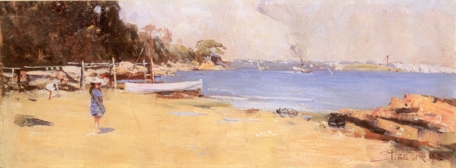Sirius Cove, Sydney Harbour
Arthur Streeton

Details
- Artist
- Arthur Streeton
- Title
- Sirius Cove, Sydney Harbour
- Year
- 1895
- Medium
- oil on cedar panel
- Size
- 11.2 x 29.6 cm
- Details
signed lower right: Streeton 95
- Stock Number
- 290107
Sold This artwork has been sold. Please contact us for similar artworks.
Provenance
Mr Jack Brewster
W.G. Saunders
''Australian Paintings'', Christies, Melbourne, 6 October 1976, lot 306
private collection, Melbourne
acquired by Mr Frederick D. Bladin in the early 1980s
''The Estate of the late Frederick D. Bladin'', Christies, Melbourne, 2 April 2003, lot 12
private collection, Melbourne
Lauraine Diggins Fine Art, Melbourne
private collection, Melbourne
Exhibited
''Arthur Streeton and the Australian Coast'', Mornington Peninsula Regional Gallery, 11 December 2004 - 6 March 2005
Literature
Smith, G., "Arthur Streeton and the Australian Coast", in Smith, G., Streeton, O.,Churcher, A.M. (eds). ''Arthur Streeton and the Australian Coast'', Mornington Peninsula Regional Gallery, 2004, p. 18
Further Information
Named after the frigate Sirius which docked at the cove for repairs in 1789, Greater Sirius Cove and Little Sirius Cove are part of the Mosman stretch of coastline, which lies on the northern side of Sydney Harbour. ''Sirius Cove'' was painted while Streeton was living at Curlew Camp at Little Sirius Cove, near to the present site of Taronga Park Zoo. Curlew was one of several camps established in this area during the late nineteenth century. Barry Pearce noted that by this date: "There were... colonies of
tent-dwellers on some of the beaches and bay shores. Initially established in the 1880s as the weekend camps of young men wishing to escape the 'foetid air and gritty of the dusty, dirty city', they beacme permanent dwellings in the depression of the 1890s..." (Pearce, B., Bohemians in the Bush / The Artists' Camps of Mosman, Sydney, 1991, p.31). Curlew Camp and the camp at Edwards Beach, north of Balmoral, were the only two locations to fall into the specific classification of artists' camps, but it was to be Curlew that became the most famous of the camps, due to the presence of Streeton and Roberts who lived and painted there periodically between 1891 and 1897. Both the lifestyle and many of the works produced at Curlew Camp are regarded by many to express the culmination and golden age of the Australian school of
Impressionism.
Streeton was familiar with artistic camp life, having founded the Heidelberg camp with Roberts and Conder in 1888. He first travelled to Sydney in 1890 in order to make minor changes to his painting ''Still Guides the Stream, And Shall Forever Glide'' which had been purchased by the Art Gallery of New South Wales. Further visits in consecutive years followed until he finally
decided to make Sydney his base. In December 1892 Streeton joined Tom Roberts as a resident of Curlew Camp where he was to remain until 1897, apart from intermittent trips interstate and on painting expeditions.
Although they did live in cavas tents, the artists and other occupants of Curlew Camp enjoyed certain amenitites and luxuries, including an English style garden that Streeton planned and tended around the tent that he shared with Roberts. Mary Eagle has
noted that: "Some of these camps, like the Curlew, were admistered after the style of a boarding-house, with a manager, cook, and rules relating to such matters as visitors and sanitation." (Eagle, M., The Oil Paintings of Arthur Streeton in the National Gallery of Australia, 1994, p.61)
In ''Sirius Cove'', Streeton's characterisitc horizontal separation of land, sea and sky is interrupted by the sweeping curve of the
beach and rocky foreshore. The panel is separated into the bands of sea and shore, with the rocky pile in the lower right corner, (which has received Streeton's trademark square stroke treatment), providing a compositional counterpoint to the green
scrub in the upper left corner. The expanse of golden sand that dominates the painting draws the viewer's attention to the figure
of the little girl in the blue dress and white hat, while on the horizon line the green mass of Garden Island, which had been a naval base since the mid 19th century, is clearly visible.
The design on the reverse of the painting indicates that the work was painted on a board that would have originally been part of
a model kit intended for assembly.
An especially delightful and unusual feature of Sirius Cove are the two figures of the young girls on the shore. Streeton's
landscapes are predominantly unpopulated so the most closely related works in terms of date and the depiction of figures on the beach are therefore ''At Coogee'' (National Gallery of Victoria) and ''Manly Beach'' (Bendigo Art Gallery). ''At Cogee'' depicts two child-like figures playing on the foreshore against the backdrop of a long, breaking wave but these figures are much more
sketch-like than the children who appear in ''Sirius Cove''.
''Sirius Cove'' displays the tremendous charm that is the overwhelming characteristic of Streeton's work from this period of intense creative achievement. Tones of rich blue and gold dominate the scene and the sunshine-frenched canvas bears witness
to Tom Roberts' initial summation of Streeton's work - that it was filled with light and air.
